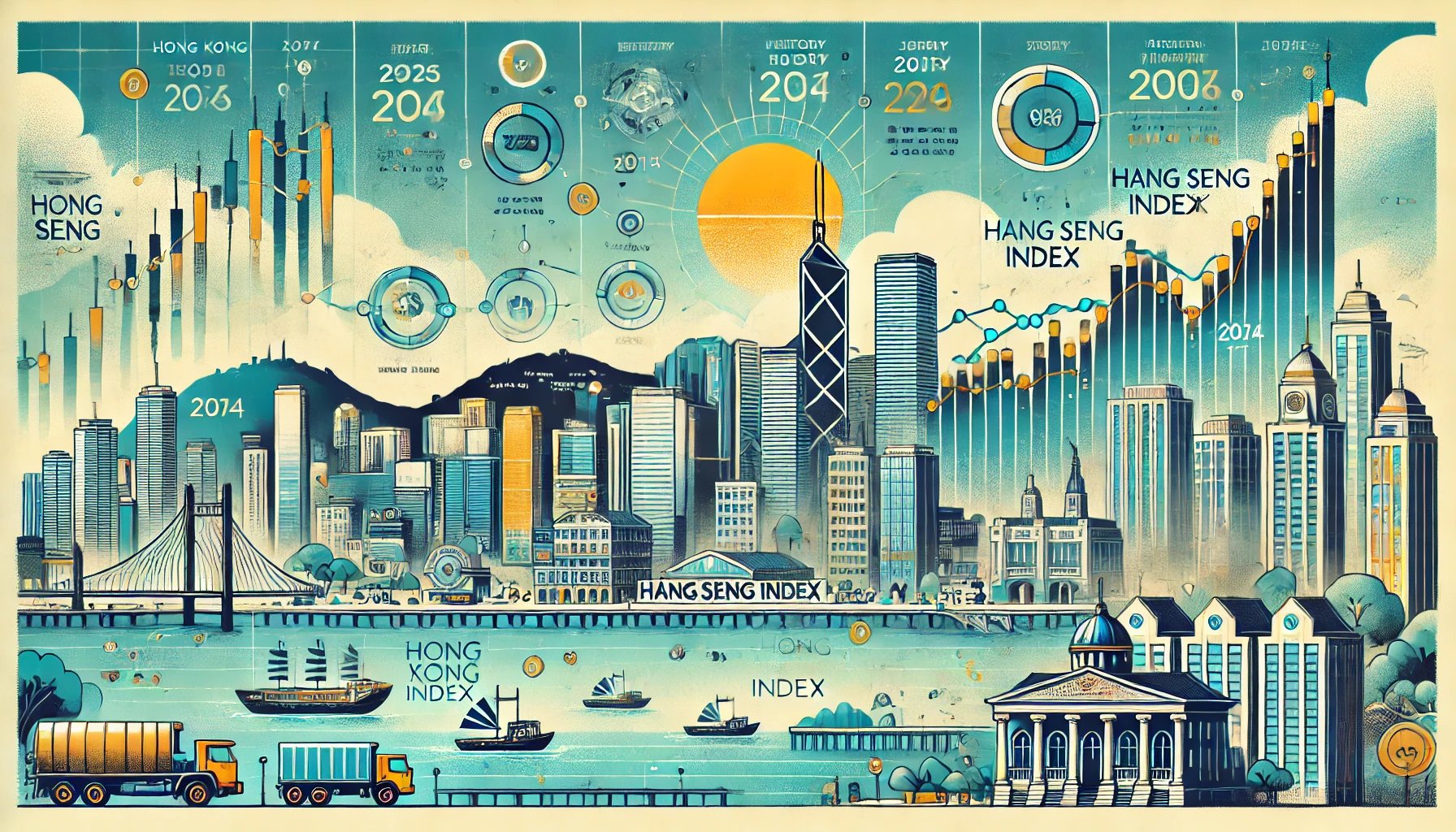Your cart is currently empty!
The History of the Hang Seng Index

The Hang Seng Index (HSI) is one of the most well-known stock market indices globally, representing the overall performance of the Hong Kong Stock Exchange. Since its inception, the Hang Seng Index has played a critical role in mirroring the financial health, stability, and growth of Hong Kong’s economy. This article will explore the history of the Hang Seng Index, its evolution, and its significance in the broader financial world. For a deeper understanding of the index and its components, you can explore this comprehensive guide.
Origins of the Hang Seng Index
The Hang Seng Index was established on November 24, 1969, by Hang Seng Bank, a prominent bank in Hong Kong. The bank’s Managing Director at the time, Stanley Kwan, developed the index as a tool to measure the performance of the Hong Kong stock market. The creation of the Hang Seng Index was an important milestone for Hong Kong, providing a benchmark that investors could use to gauge the overall performance of the market and economy.
The motivation behind creating the Hang Seng Index was to reflect the broader economic climate of Hong Kong accurately. The index aimed to provide both local and international investors with a clear understanding of the state of Hong Kong’s financial markets and to promote transparency and investor confidence.
Components and Composition of the Index
The Hang Seng Index initially consisted of 33 companies, which represented approximately 65% of the total market capitalization of the Hong Kong Stock Exchange. The companies were carefully selected to represent different sectors of the Hong Kong economy, including finance, utilities, properties, and commerce. Today, the Hang Seng Index has expanded, and its components cover a wide variety of industries that contribute to Hong Kong’s economic growth.
The selection criteria for the companies included in the index have evolved to ensure the index accurately reflects market conditions and remains representative of the broader economy. Companies are chosen based on criteria such as market capitalization, trading volume, and representation of key industries.
The Hang Seng Index is divided into several sub-indices to provide a more granular view of the market. These sub-indices represent sectors like finance, utilities, properties, commerce, and, more recently, technology and innovation. This diversification makes the Hang Seng Index a valuable indicator of the overall health of Hong Kong’s economy.
The Development and Growth of the Hang Seng Index
Since its inception in 1969, the Hang Seng Index has undergone significant changes and developments. The index started with a base value of 100 points, which represented the total value of the companies included on the starting date. Over time, the index has experienced rapid growth, reflecting the economic progress of Hong Kong and the increasing influence of China on its financial markets.
One of the defining characteristics of the Hang Seng Index is its ability to adapt to changes in the market environment. The inclusion of mainland Chinese companies in the index marked an important turning point, as it reflected the growing economic ties between Hong Kong and China. By incorporating mainland Chinese firms, often referred to as H-shares, the Hang Seng Index has become an important barometer of the economic integration between Hong Kong and China.
In the 1980s and 1990s, the Hang Seng Index experienced significant growth, largely due to Hong Kong’s economic expansion, its strategic importance as a gateway to China, and its favorable business environment. During this time, Hong Kong solidified its position as a global financial center, and the Hang Seng Index became a preferred benchmark for investors seeking exposure to Asian markets.
Impact of Major Events on the Hang Seng Index
The Hang Seng Index has faced numerous challenges and fluctuations over the years, reflecting both global and regional economic conditions. Here are some of the key events that have shaped the history of the Hang Seng Index:
1. 1987 Stock Market Crash
The Black Monday crash of October 1987 was a major global financial event, and the Hang Seng Index was no exception. The index fell dramatically, mirroring the downturn experienced by other global markets. The crash highlighted the interconnected nature of global financial systems and emphasized the vulnerability of stock markets to sudden shifts in investor sentiment.
Despite the sharp decline, the Hang Seng Index managed to recover over the following years, thanks to the resilience of Hong Kong’s economy and its strong fundamentals. The recovery demonstrated the importance of investor confidence and the ability of the market to withstand external shocks.
2. 1997 Asian Financial Crisis
The Asian Financial Crisis of 1997 had a profound impact on the Hang Seng Index. During the crisis, the index experienced a significant drop as investor confidence in Asian markets plummeted. The crisis was triggered by the collapse of the Thai baht, which led to a domino effect across other Asian economies, including Hong Kong.
Despite the turmoil, the Hong Kong government intervened by buying shares in local companies to stabilize the market. This intervention helped the Hang Seng Index recover, although it took several years for the market to regain its previous levels. The Asian Financial Crisis highlighted the importance of government intervention and financial stability in times of economic uncertainty.
3. 2003 SARS Outbreak
The SARS outbreak in 2003 was another major event that impacted the Hang Seng Index. As the outbreak spread across Hong Kong and other parts of Asia, economic activity slowed, and investor confidence declined. The Hang Seng Index experienced a sharp drop during the height of the outbreak.
However, once the SARS crisis was brought under control, the Hang Seng Index rebounded, and Hong Kong’s economy experienced a strong recovery. The rapid rebound demonstrated the resilience of Hong Kong’s economy and its ability to bounce back from public health crises.
4. Global Financial Crisis of 2008
The 2008 Global Financial Crisis was a pivotal moment for financial markets worldwide, and the Hang Seng Index was no exception. The crisis, which began with the collapse of the US housing market, led to a global credit crunch and severe economic downturn. The Hang Seng Index experienced a sharp decline during this period, losing a significant portion of its value.
The Hong Kong government, along with central banks around the world, took measures to stabilize the financial system. The index eventually recovered, fueled by stimulus measures and a rebound in global economic activity. The crisis underscored the vulnerability of financial markets to systemic risks and the importance of coordinated global responses to economic challenges.
5. Integration with Mainland China
The integration of Hong Kong’s financial markets with mainland China has been a major factor in the evolution of the Hang Seng Index. With the introduction of Shanghai-Hong Kong Stock Connect in 2014 and Shenzhen-Hong Kong Stock Connect in 2016, mainland Chinese investors gained greater access to Hong Kong-listed stocks, and vice versa.
This increased integration has made the Hang Seng Index more reflective of China’s economic growth and development. As more Chinese companies were listed on the Hong Kong Stock Exchange, the index’s composition shifted, incorporating a larger proportion of mainland firms. This integration has made the Hang Seng Index a critical benchmark for those looking to invest in the Chinese economy.
The Evolution of the Hang Seng Index
Over the years, the Hang Seng Index has evolved to reflect changes in the market and the broader economy. One of the most significant changes has been the inclusion of technology companies. With the rise of tech giants like Tencent and Alibaba, the Hang Seng Index now includes some of the most valuable technology firms in the world.
This evolution has made the Hang Seng Index more representative of the modern economy, as technology and innovation play an increasingly important role in economic growth. By incorporating technology companies, the index has remained relevant and has continued to attract investors looking for exposure to cutting-edge industries.
The Hang Seng Index has also been adapted by introducing additional indices, such as the Hang Seng China Enterprises Index (HSCEI), which tracks the performance of Chinese companies listed in Hong Kong. This index, along with other sub-indices, provides investors with a more detailed view of different segments of the market, allowing for more targeted investment strategies.
Significance of the Hang Seng Index in the Global Market
The Hang Seng Index is not just a barometer of Hong Kong’s economic health—it also holds significant importance for global investors. As one of the most liquid and well-established indices in Asia, the HSI provides valuable insights into the performance of Chinese and Asian markets. The index is widely tracked by investors and fund managers, and its movements are closely watched as an indicator of economic trends in the region.
For foreign investors, the Hang Seng Index represents an opportunity to gain exposure to the Chinese economy while benefiting from Hong Kong’s transparent regulatory environment and developed financial infrastructure. As China continues to play an increasingly significant role in the global economy, the importance of the Hang Seng Index as a benchmark for Asian equities will likely continue to grow.
Investing in the Hang Seng Index
Investors looking to gain exposure to the Hang Seng Index have several options, including Exchange-Traded Funds (ETFs) that track the index, mutual funds, and direct investments in the constituent companies. ETFs, in particular, are a popular choice for those who want diversified exposure to the Hong Kong market without having to pick individual stocks.
Before investing, it’s important to understand the risks associated with the Hang Seng Index. Given its exposure to the Chinese economy, the index can be subject to significant volatility, influenced by factors such as government policies, economic data releases, and global market conditions. As always, investors should consider their risk tolerance and investment goals before allocating capital to the Hang Seng Index or any of its related funds.
Conclusion: The Legacy and Future of the Hang Seng Index
The Hang Seng Index has a rich history, closely tied to the economic development and transformation of Hong Kong. From its inception in 1969 to its evolution into a benchmark that includes some of the world’s largest companies, the Hang Seng Index has been a reliable indicator of Hong Kong’s financial health and growth. The index has weathered numerous economic storms, adapted to changing market conditions, and continues to serve as a key barometer for investors around the globe.
As Hong Kong’s financial markets become increasingly integrated with mainland China, the Hang Seng Index will likely continue to play a vital role in reflecting the economic dynamics of the region. Whether you are an investor, a financial professional, or simply someone interested in the history of global finance, the Hang Seng Index offers valuable insights into the growth and resilience of one of Asia’s most important economies.

Mr. Rajeev Prakash
Rajeev is a well-known astrologer based in central India who has a deep understanding of both personal and mundane astrology. His team has been closely monitoring the movements of various global financial markets, including equities, precious metals, currency pairs, yields, and treasury bonds.
